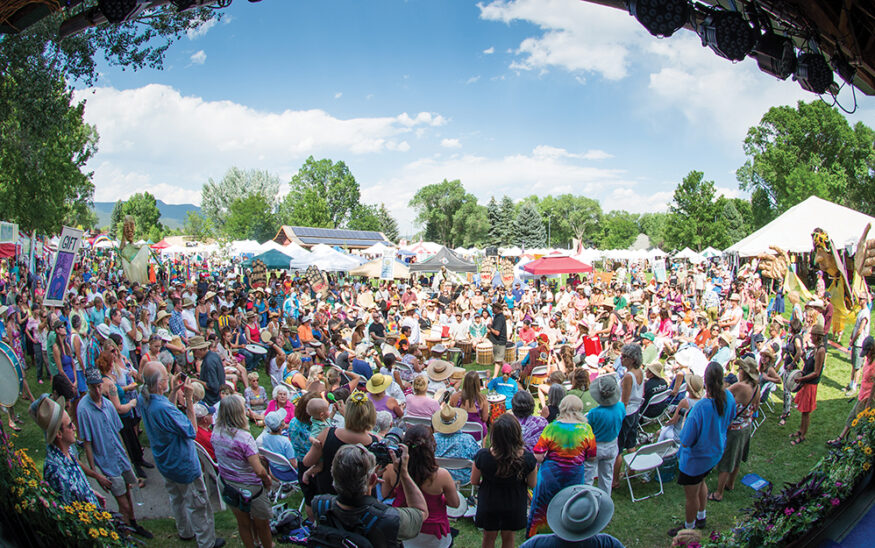Communities Push to Create Places Where Artists Can Flourish
Affordability is top of mind for creatives throughout Colorado
Eric Peterson //June 13, 2018//


Communities Push to Create Places Where Artists Can Flourish
Affordability is top of mind for creatives throughout Colorado
Eric Peterson //June 13, 2018//

Once considered too touchy-feely for economic development, the arts are now at the vanguard of Colorado’s strategy for growth. Arts advocates have gotten a seat at the table for policy discussions in communities from Steamboat Springs to Mancos.
There’s a good reason for that: The difference between a vibrant downtown and a desolate one can often be tied to the presence of local creatives.
But there’s a stiff headwind: The skyrocketing price of Colorado real estate. The median home value in the state is about $350,000, according to data from Zillow. That’s up almost 10 percent in the last year, outpacing wage growth by a wide margin.
High housing costs are especially tough on artists, especially young artists struggling to establish a career. But community leaders across the state have increasingly pushed for projects that cater to creatives.
With 30 live/work spaces and a shared gallery, Artspace Loveland has had a long waiting list since it opened alongside the abandoned 1890s-era Loveland Feed and Grain building in the Northern Colorado city in early 2016.
“It’s a very interesting idea — and the price is right,” says Mary Connole, the resident manager and a writer/photographer. “Being broke is one commonality (among the residents), and commitment to the arts is the other.”
The impact of the Artspace project extends beyond providing 30 wallet-friendly units. “It really cleaned up the ugliest, most blighted corner of downtown Loveland,” says Jeff Feneis, director of development at the Loveland Housing Authority. There are plans to reuse the old Feed and Grain as retail and studio space.
The development’s owner, Artspace, is a Minneapolis-based nonprofit that’s in the thick of the issue, both in Colorado and nationwide. Since 1990, it has completed more than 35 projects with about 2,000 live/work units.
“We serve the workforce population,” says Shannon Joern, Artspace vice president, strategic advancement. “When we are creating live/work housing, we are typically using that low-income housing tax credit [LIHTC] tool that has income and stewardship requirements.” That means residents must make between 30 percent and 60 percent of area median income (AMI), as the federal program requires.
“For the residents a lot of times, this is about the opportunity for creative people to live affordably and focus more time and effort on their creative pursuits,” Joern says. “It often allows them to quit one or two of their day jobs and focus on their creative work.”
Case in point: A 2015 Artspace survey found that 75 percent of tenants across five projects said their residency increased their creative productivity. And other effects, from increasing surrounding property values to expanding access to the arts, also make good business sense.
PROJECTS ABOUND

In Colorado, Artspace is working on potential projects in Denver, Colorado Springs, Lakewood, Fort Collins, Avon, Carbondale and other municipalities. “There’s no other state where we have that many dots on the map,” says Wendy Holmes, Artspace’s senior vice president, consulting and strategic partnerships.
It’s not just about supporting the arts, or economic development: It’s also about downtown revitalization and historic preservation. “Many communities, especially small mountain communities and rural communities, are hungry for these kind of projects that address so many community concerns,” Joern says.
Artspace also has partnered with Colorado Creative Industries (CCI), part of the Colorado Office of Economic Development and International Trade, on the Space to Create Colorado program. It will advance nine mixed-use projects that incorporate affordable live/work space for artists.
With 30 units slated for completion in 2020, Trinidad will be the first Space to Create project to break ground in June. Ridgway and Paonia have been selected for subsequent projects in their respective regions.
DOWNTOWN TRINIDAD REAPING BENEFITS

The resources brought to bear in Trinidad, including LIHTCs (the federal tool that has helped finance 3 million affordable units nationally since 1987), state and city funding and philanthropic gifts have far exceeded the initial target of $7 million for 15 units.
“It is now a scattered-site project,” says Joern, citing three historic buildings that will be restored in downtown Trinidad as well as new construction. “It’s stunning. It’s a more than $15 million project.”
Local government support is critical, CCI Executive Director Margaret Hunt says. But there are also situational factors.
“We picked Paonia because they lost 1,200 mining jobs and we wanted to diversify their economy,” says Hunt, noting that Trinidad was selected in part because of a long economic downturn. “We’re looking for maximum impact.”
Colorado Creative Industries has certified 21 official Colorado Creative Districts since 2013. “Space to Create came about because we had this really successful creative district program,” Hunt says, noting that affordable housing is a top concern in districts from Greeley to Telluride.
Trinidad’s certification as a creative district has already reaped economic rewards: The downtown commercial vacancy rate dipped from 61 percent in 2015 to 29 percent at the end of 2017. The Space to Create project has helped attract such notable private investors as preservationist Dana Crawford and Phil Long CEO Jay Cimino.
APPEALING TO YOUNG ARTISTS
Long an arts hub, Salida faces a different challenge: The average listing price for a single-family home is now more than $400,000, up more than 50 percent in the last five years.
But the uptick hasn’t sapped Salida’s creative vitality. ”(Artists) came in the ‘70s and ‘80s when the downtown was abandoned,” says Michael Varnum, program manager for the Salida Creative District. “They were able to purchase homes at that time.”
Today, it’s a different story. Downtown Salida has few empty storefronts, but plenty of public art and an undeniable sense of place. For all of the progress, the new challenge involves younger artists not being able to find affordable places to live. “It affects us all, and creatives are a huge part of the population in Salida,” Varnum says. “There are hundreds of artists.”
Glen Van Nimwegen, Salida’s community development director, says his primary tool for promoting affordability is negotiating with developers to include affordable housing in projects in exchange for zoning variances or annexation. “We’re primarily using carrots,” Van Nimwegen says. “If you want us to do something, you’ve got to give something.”
The target is for 12.5 percent affordable units, but he says some developers are willing to go higher. A recently approved mixed-use project with 122 residential units, Salida Crossings, will include 30 units priced for households earning 70 percent to 80 percent AMI. And that might even be a little high. “Sixty percent AMI is where the demand is,” Van Nimwegen says.
It follows that Salida officials are searching for more ways to incentivize affordability. “Now we’re looking at utilities,” Van Nimwegen says. “That is a big impediment to making things affordable. Multi-family, single-family, condo, townhome, they all pay the same fee (for water), and we know higher density uses less water. It’s intrinsically unfair.”
In the Roaring Fork Valley, home to some of Colorado’s priciest real estate, artists have been moving down valley from Aspen to Carbondale for decades. “This has been going on for years and years,” says Amy Kimberly, executive director of Carbondale Arts, an arts-advocacy nonprofit founded in 1974.
The trend isn’t sustainable, she notes, as Carbondale’s median home value has crested to more than $500,000 in the last year. “Because of the creativity and the vitality, it’s the hottest spot to live, and you can’t find a place to buy or rent.”
Now Carbondale is experiencing a familiar exodus.
“We’re losing people to Paonia,” Kimberly says. “We have so many creative people in Carbondale. I love it, but if we don’t figure out something with housing, we’ll lose it.”
One key: density. “We do have to go a little taller,” Kimberly says. “That’s a conundrum we have to figure out in Colorado, because we have so many beautiful views.” For more affordable housing in Carbondale, she adds, “I’d give up my view. I would. Let me rephrase that: I’d give up my view for a cool project with affordable rates.”
There’s a challenge: Carbondale is the least affordable spot in Garfield County, where the LIHTC target of 60 percent AMI translates to a maximum household income of $29,000. “Most people [in Carbondale] aren’t eligible,” Kimberly says.
For that reason, LIHTC projects aren’t a good fit for Carbondale. “Our biggest hurdle is to figure out how you can do these projects without tax credits,” Kimberly says. The challenge is “trying to find that balance of philanthropy and entrepreneurship” that could fund affordable housing for the town’s significant population of creatives.
But she says she’s optimistic. “I actually believe, and I think our town believes, we will be able to find this new model,” she says. “We have to find it.”
If that sounds like a mandate, that’s because it is. Creativity is economic fuel for Carbondale and many other communities in Colorado, and it simply doesn’t mix well with sky-high housing costs.
As Artspace’s Holmes puts it, “If a community doesn’t preserve affordable spaces for creative people, it’s not a place a lot of other people want to be.”






















